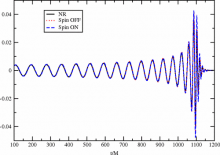
Abstract
We describe in detail full numerical and perturbative techniques to compute the gravitational radiation from intermediate mass ratio (IMR) black-hole-binary (BHB) inspirals and mergers. We perform a series of full numerical simulations of nonspinning black holes with mass ratios q=1/10 and q=1/15 from different initial separations and for different finite difference resolutions. The highest resolution runs reach phase accuracies with errors <0.05 radians when the gravitational wave frequency is 0.2/M. In order to perform those full numerical runs, we adapted the gauge of the moving punctures approach with a variable damping term for the shift. We also derive an extrapolation (to infinite radius) formula for the waveform extracted at finite radius. For the perturbative evolutions we use the full numerical tracks, transformed into the Schwarzschild gauge, in the source terms of the Regge-Wheller-Zerilli Schwarzschild perturbations formalism. We then extend this perturbative formalism to take into account small intrinsic spins of the large black hole, and validate it by computing the quasinormal mode (QNM) frequencies, where we find good agreement for spins |a/M|<0.3. Including the final spins improves the overlap functions when comparing full numerical and perturbative waveforms, reaching 99.5% for the leading (l,m)=(2,2) and (3,3) modes, and 98.3% for the nonleading (2,1) mode in the q=1/10 case, which includes 8 orbits before merger. For the q=1/15 case, we obtain overlaps near 99.7% for all three modes. We discuss the modeling of the full inspiral and merger based on a combined matching of Post-Newtonian, Full Numerical, and Geodesic trajectories.